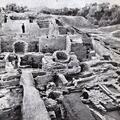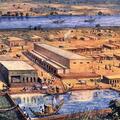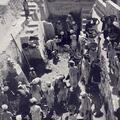Deity seal from Mohenjo-daro. E.J.H. Mackay writes of what he calls a "deity, seated in what may be a yogi attitude" where, in this case, "the stool is omitted, however, and the figure is apparently seated upon the ground.
344 posts, also carried on our Facebook page, about the ancient Indus Valley civilization, including important news, research and occasional visits to museums with ancient Indus artifacts.
May 28, 2015
Figurine with flower headdress from Harappa and a reconstructed headdress in gold found with a serving girl found with Queen Puabi at the royal burials at Ur in Mesopotamia ca. 2600 BCE.
May 26, 2015
Figurine of a cheeky spotted dog from Chanhu-daro shows the personality Indus craftsmen could imbue a 7 cm sized figurine with. From the Museum of Fine Arts, Boston collection based on the 1935 US-led excavations at Chanhu-daro, Sindh. More at Museum of Fine
May 20, 2015
A rarely seen image of deep diggings at Mohenjo-daro in 1950 gives some sense of the density of urban construction in the city.
May 11, 2015
Includes long carnelian beads and necklace, fired steatite beads and gold objects, terra cotta bangles and detail in red, white and green, metal bangles and gold and agate ornaments.
See also Carnelian Beads and Ornaments and Jewelry.
Apr 20, 2015
The nautical historian Basil Greenhill makes an interesting point about why this boat style may have endured on the Indus: "As for the punts [long, narrow, flat-bottomed boats, square at both ends and propelled with a long pole, used on inland waters chiefly
Apr 13, 2015
A rare white marble cylinder seal from Jiroft.
Apr 9, 2015
Mohenjo-daro 50 Year Ago in 6 shots. A long view towards the Great Bath, the Great Bath, a narrow street, a street with a covered drain, a photographer at the site, and the Stupa Mound, all in 1962.
See also Urban Construction of Mohenjo-daro.
Apr 6, 2015
John Marshall writes "House 13 in the VS Area has a more elaborate plan . . . On its ground floor are four fair-sized courts, ten smaller rooms, three staircases, a porter's lodge, and a well-chamber.
Apr 4, 2015
This seal plays an illustrative role in Asko Parpola's essay Beginnings of Indian Astronomy with Reference to a Parallel Development in China.
Mar 30, 2015
Movable head of a bovine figurine from Harappa. Some movable figurine heads are pierced through the horns on either side of the head. The movable heads of figurines often depict cattle.
Mar 24, 2015
A reimagining of life in Lothal 4,000 years ago, satellite images of the town in context of today's landscape, and the discoverer, S. R. Rao's drawings of the town plan, bead factory and warehouse.
Mar 17, 2015
A perfectly cut unicorn seal with a sign right above the horn. The seal was found in Harappa. The year is given at approximately 2000 BCE, when craftsmanship in seal manufacture was probably at its height. It was purchased by the Ashmolean Museum in Oxford, UK
Mar 14, 2015
Impression of an Indus-style cylinder seal of unknown Near Eastern origin in the Musee du Louvre, Paris. All indications are that the Bronze age was built on a robust international trade system.
Mar 11, 2015
Workers digging a deep pit during the 1935-36 excavations in Chanhu-daro, Sindh. Chanhu-daro was the only American run pre-partition Indus excavations, by the Museum of Fine Arts in Boston, and led by Ernest J.H. Mackay.















